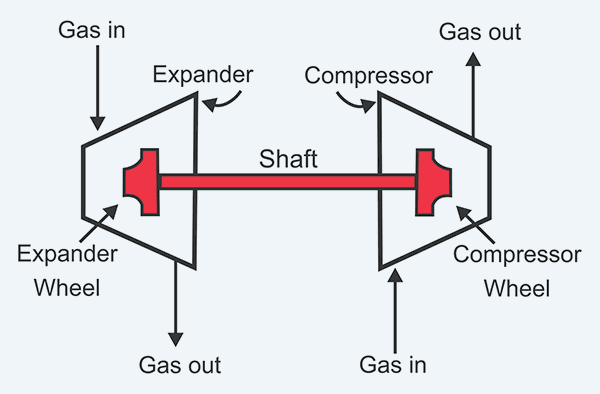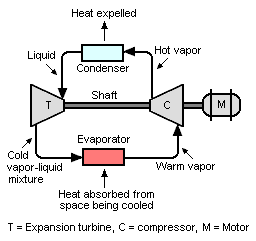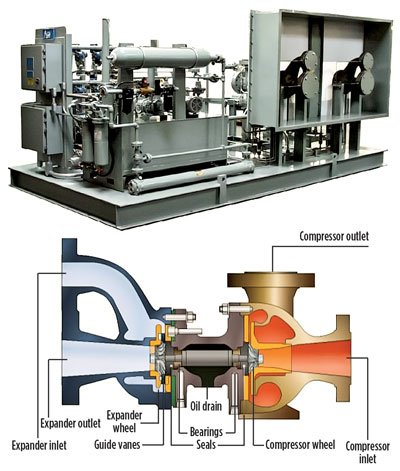Turboexpanders, Use, and Advantages in the Gas Industry
Turboexpanders, Use, and Advantages in the Gas Industry
Nowadays, innovative and innovative trends are presented in the hydrocarbon and chemical process industries that ensure a higher rate of demand in terms of safety, quality and efficiency of results. In this sense, procedures are designed that maximize effectiveness through ideal teams that take advantage as much as possible of the main resources in favor of the objectives and set of tools.
In that order of ideas, turboexpander is given entrance that in other terms is conceived like machines or industrialized equipment that optimize the processes through a turbodinámico procedure that compress the pressure and the temperature of a flow of gas to increase its volume and with This will facilitate the specialized technique of liquefying or condensation. It is worth noting that said liquefied natural gas for other processes of the slopes that make up the hydrocarbon industry and thermal energy minimize costs and facilitate time and effort in transporting and using the product in question.
a) Turboexpanders
The turboexpanders are turbo machines designed to reduce the pressure and the temperature of the gases, increasing their volume to be able to liquefy them or to condense them, this device converts the energy of the gas pressure into useful work which is exploited in the form of work produced for generating power. The work is extracted by a centrifugal compressor that is helped by a "Re-Compressor" that increases the gas flow after the condensed liquids of LGN have been extracted (The wheels of the expander and the compressor are joined by the ends of a common axis). In general, the word turboexpansor or simply expander is used to refer to the complete system, formed by the turbine itself where the actual expansion of the fluid occurs and the associated compressor on the same axis that is the load, used to compress some fluid of process. When the power to be extracted is not significant, a hydraulic brake is usually used as a load, in this case, the energy dissipates in air coolers, losing it to the medium.

source
The Turboexpanders were developed for gas processing plants in order to recover ethane and propane. For the use of the Turboexpansor, it is necessary that there is a pressure drop in the gas flow, its most efficient use is with rich gas and additionally, ethane recovery can be achieved above 30%. Subsequently, its use for the power generation industry was extended to both geothermal applications or energy recovery in gas pipelines. In summary Turboexpansores have the following applications and ranges of operation:
• Turboexpansor / Compressor from 100 to 17000 kW (Applications with Natural Gas)
• Turboexpansor / brake up to 100 kW (Applications with Air)
• Turboexpansor / Electric generators from 100 to 17000 kW (Applications with Natural gas)
• Turboexpansor / Electric generators from 100 to 17000 kW (Applications with steam).
b) Mechanism of operation
Gas Supply: The supply current is made up of gas supply that must be clean, dry, sweet, that is, it does not have any contaminants or impurities in its input composition, and with a specific pressure to comply with the system requirements.
Turboexpansor: This decreases the inlet area of the gas stream increasing the outlet area thereof, giving rise to an expansion, and power generation, this handles a flow rate of 50 MMPCED.
Condensate Handling: This affects the formation of any liquid produced by condensation, so the f1 scrubbers are located at the entrance and exit of the expander f2.
Handling of liquid that comes out of the scrubber at the entrance F1 and the liquid from the scrubber to the expander outlet that is F2 for its best obtaining in the Process: For this, a mixer is used which collects the liquid.
Lubrication: It involves the simple manual filling of the oil or grease containers, or the application of lubricant pressure in the fittings, or the automatic lubrication of sumps with rings, chains or tables. However, high-speed bearings require more complex systems, to ensure a continuous supply of clean oil.
Cooler: Large machines require an oil cooler to eliminate the heat generated in their bearings; Usually, the oil is kept in a tank and pumped to the bearing by means of coolers and oil filters. The temperature of the oil is controlled to maintain the constant viscosity and the sufficient oil pressure is conserved, in order to ensure a uniform flow through the holes leading to the individual bearings. The lines for the return oil describe slopes from the bearings to the tank and have generous dimensions to allow the passage of the foam, which is produced together with the return oil.

source
c) Characteristics of turboexpanders.
- The turboexpander is a piece of equipment that is located on a skid with its corresponding gas seal and lubrication systems.
- The system as such is designed for easy maintenance or operation.
- The turboexpansor is made up of three basic components:
- The expansion housing with its suction and discharge flanges, nozzle, vanes, guides, flow control valves and throttle control valves.
- The central section (Mechanical Center Section "MCS"), which is the site where the rotating part of the equipment is located.
- The compression housing with its suction flanges and nozzle discharge.
- The ability to work with liquid phase makes them suitable for the use of geothermal energy.
- Another important feature is the design of the mobile nozzles which allow working efficiently in a wide range of pressures and flow rates adapting their shape according to the load conditions.
- In this type of turbine part is expanded in the nozzles entering the gas tangentially to the rotor, combining the radial fluid velocity with the peripheral speed of the rotor so that there is no impact with the walls, allowing to work as mentioned above with part of the fluid in a liquid state.
d) Uses and Applications of turboexpanders.
The turboexpander is a turbine of a single impeller or wheel similar to a steam turbine. It is a free circulation machine that reduces the pressure and temperature of a gas stream and converts the energy of the gas pressure into useful work.
The work is extracted by a centrifugal compressor that is aided by a re-compressor that increases the gas flow after the condensed NGLs have been extracted. (The wheels of the Expander and the compressor are joined by the ends of a common axis.) This combination of the expander and the compressor in a single machine known by a variety of names, with Expander / Compressor, Expander Brake-Compressor, and Expander / Booster -Compressor being the most common. The Expander/compressor (Expander compressor) is the heart of the cryogenic plant.
Turboexpanders are typically used in natural gas processes that have high feed pressures (more than 400 psig), products with variable feed and where a large amount (greater than 30%) of ethane recovery is desired. They consist of alternating sets of nozzles and rotating vanes through which steam or gas flows in a stable expansion process. The turboexpander is also used to convert the energy of a gas stream that expands into a mechanical work
The use of the turboexpander, however, does not eliminate the need for the Joule Thompson expansion valve used in conventional refrigeration systems. In a turboexpander system, the valve normally refers to the bypass valve of the expander allowing a more efficient starting and stopping of the turboexpansor.
The valve also allows continuing the process if the turboexpansor is offline or if the flow increases beyond the speed capacity of the turboexpansor. Ideally, the valve has the same characteristics of capacity and flow since the turboexpander produces a smooth transition between the devices The turboexpander in a much more efficient device than a valve, making an important seal that prevents the loss of energy.

source
e) Industrial applications of turboexpanders.
Although turboexpanders are commonly used at low temperatures in processes, they are used in many other applications as well.
- Extraction of liquid natural gas hydrocarbons:
Natural gas consists mainly of methane (CH4), as well as various amounts of heavier hydrocarbon gases such as ethane (C2H6), propane (C3H8), normal butane (nC4H10), isobutane (iC4H10), pentanes and even hydrocarbons from the higher molecular weight. Crude gas also contains various amounts of acid gases such as carbon dioxide (CO2), hydrogen sulfide (H2S) and mercaptans such as methanethiol (CH3SH) and ethanethiol (C2H5SH). When transformed into finished products, these are the heavier hydrocarbons referred to collectively as NGL (natural gas liquids). The extraction of the NGL often involves a turboexpansion and a low column distillation temperature (called demethanizer). The inlet gas is cooled to about -51 ° C in a heat exchanger. The gas resulting from the liquid mixture is separated into a stream of liquid gas and a stream. The flow of liquid flows through a valve and is subjected to an expansion of the regulation of an absolute pressure from 62 bar to 21 bar, which is an isenthalpic process, (ie, a constant enthalpy process) that results in the reducing the flow temperature from about -51 ° C to about -81 ° C. The gas flow enters the turboexpansor separator where it is subjected to an isentropic expansion of an absolute pressure of 62 bar to 21 bar which lowers the temperature of gas from about -51 ° C to about -91 ° C, as it enters the demethanizer to serve as the reflux distillation. The liquid from the top tray of the demethanizer (at around -90 ° C) will be processed through the cold box where it is heated to about 0 ° C as the incoming gas cools, and then it is returned to the bottom of the demethanizer. Another flow of liquid from the bottom of the demethanizer (at about 2 ° C) will be processed through the cold box and returns to the demethanizer at about 12 ° C. In effect, the gas inlet provides the necessary heat to "reboil" the lower part of the demethanizer, the turboexpansor; and removes the heat necessary to provide reflux in the top of the demethanizer. The final product of the demethanizer is also heated in the cold box, as the inlet gas cools, before leaving the system in NGL.
source
For more information visit the following links.
- https://www.sciencedirect.com/science/article/pii/S0894177708000721
- https://eng.libretexts.org/Under_Construction/ChemEngineering_(Beychok)/Chemical_Engineering%3A/Natural_Gas_Processing
- https://en.wikipedia.org/wiki/Turboexpander
- http://www.langsonenergy.com/wp-content/uploads/2011/11/LEI-White-Paper-2011-11.pdf
- https://books.google.co.ve/books?id=Z-RY1Emx4JwC&pg=PA78&lpg=PA78&dq=Characteristics+of+turboexpanders&source=bl&ots=gXj_Gwnvrc&sig=amFcWzRCx9LLmaW-4prQ_PpSA78&hl=es&sa=X&ved=0ahUKEwjUtbjc1YjZAhWL7FMKHd0YDfQQ6AEINzAC#v=onepage&q=Characteristics%20of%20turboexpanders&f=false
👌👍